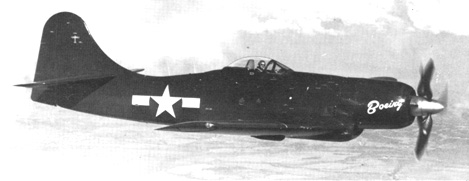Boeing XF8B-1


Boeing's Model 400 was designed to U.S. Navy requirements for a long-range carrier-based fighter bomber and a contract for three prototypes was placed with the company on May 4, 1943. The XF8B-1 designation indicated the primary fighting role of the new aircraft, but it was designed from the outset to carry an internal bomb-load of more than 3,000 lb, plus a similar external load, and had production ensued, a change of designation to one in the attack category would probably have been made. The first of the prototypes flew on November 27, 1944, and the Boeing type proved to be the largest and heaviest single-piston-engined fighter developed in the U.S.A. As with other Navy fighters, the wing outer panels folded upwards for carrier storage. The second and third prototypes were completed after the end of the war, by which time the need for the XF8B-1 had disappeared, and further development was soon discontinued.
Additional information on this aircraft
can be found at Wikipedia
here.
(updated February 2009)
Boeing XF8B-1
Type: single seat fighter bomber
Crew: 1: Pilot
Armament: six .50 inch machine guns or 20mm cannon
internal storage for four 500 lb bombs
or two 1,600 lb bombs
external racks for two 500 lb bombs
or two 1,000 lb bombs
or two 1,600 lb bombs
Specifications:
Length: 43' 3" (13.18 m)
Height: 16' 3" (4.95 m)
Wingspan: 54' 0" (16.46 m)
Wing area: 489 sq. ft (45.43 sq. m)
Empty Weight: 14,190 lb (6436 kg)
Max Weight: 21,691 lb (9848 kg) max at takeoff
Propulsion:
No. of Engines: 1
Powerplant: Pratt & Whitney XR-4360-10 28-cylinder radial
Horsepower: 3000 hp
Performance:
Range: 1305 miles (2100 km)
Climb rate: 3660 ft/min (18.6 m/sec)
Max Speed: 432 mph ( 695 km/h) at 26,500 ft
Ceiling: 37,500 ft (14438 m)
Information from "US Navy and Marine Corps Fighters"
by William Green and Gordon Swanborough
(made available by San Diego Aerospace Museum library)
If this page does not have a navigational frame on the left, click HERE to see the rest of the website.